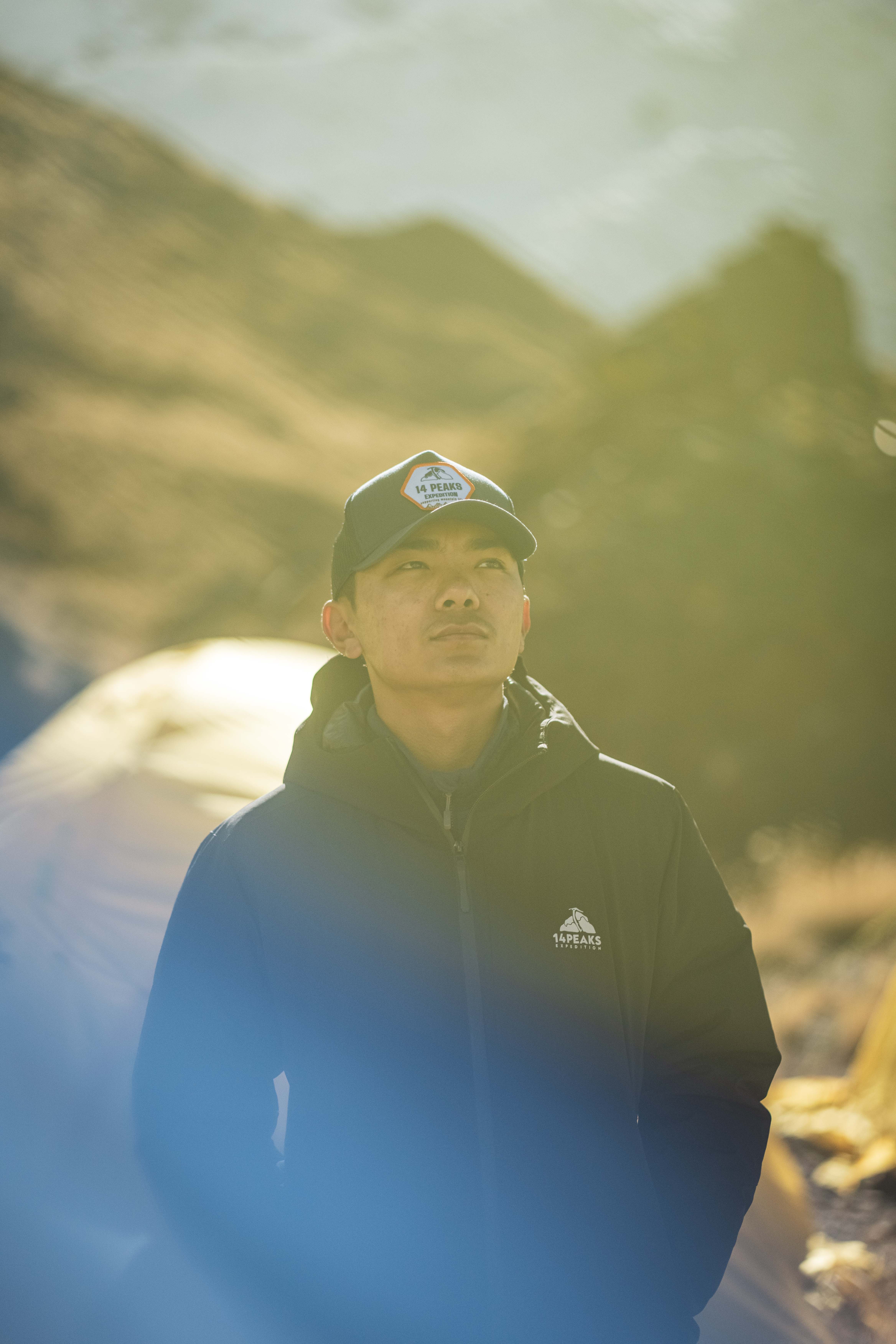
Nima Rinji Sherpa, 18, stood atop Tibet’s Mount Shishapangma at about 06:05 AM local time on Oct 09, Wednesday.
Nima Rinji Sherpa describes his scaling of the last of the world's 14 peaks above 8,000 metres as something "more than personal.” For him his climbing journey was a tribute to the entire Sherpa community who are often considered as guides and porters rather than professionals despite their extraordinary climbing skills. By setting the world record as the youngest 14 peak climber, he has not just become a member of 14 peak club–a rare feat in mountaineering–he is in fact the celebrity climber. Nima Rinji took an interest in mountaineering at an early age, completing his first recorded climb of Manaslu, the world’s eighth highest peak, when he was aged just sixteen. And just two weeks ago, on October 09, he stood atop Shishapangma in Tibet at about 06:05 AM local time. As the son of a seasoned climber, he draws inspiration from his ancestors, aiming to redefine perceptions and carve a niche beyond the traditionally perceived roles of the Sherpa community. He was the youngest climber to have scaled Kashmir’s Nanga Parbat; and the youngest climber to have scaled both Everest and nearby Lhotse in a record nine hours. A week ago, UNDP’s Monica Upadhyay and Kamal Raj Sigdel met with Nima Rinji Sherpa to discuss his remarkable journey, and better understand impacts of climate change in the entire Himalayan region in recent years.
Your latest successful ascent of Mt Shishapangma is a testament to your resilience that transcends age and boundaries. How do you feel?
I absolutely wanted to climb all the 14 peaks above 8000 meters while I was still in my teens. To work for a goal for so many years and to have finally achieved it last week is one of the happiest moments of my life. I am proud to have set another world record and keep alive the Sherpa tradition of breaking boundaries. Climbing mountains is my life now. It's brought so much joy to me and I find a lot of meaning in doing what I do. By doing so, I also want to give this message to all the young people that there is no set path in life and that they should not hesitate to take up climbing as a profession.

While people of your age are worried about their grades, you seem to be in a rush to climb the mountains. Why do you do what you do?
(Laughs) I wouldn’t say I have been in a rush, but it is true that I have always had a fascination with mountains since childhood. That is the reason why I scaled Mount Manaslu a week after I finished my final high school exams. A month later I climbed Mt Ama Dablam, followed by Mt Everest and Mt Lhotse. I became the youngest climber to scale both Mt Everest and Mt Lhotse within a record 9 hours. I then went to Pakistan and climbed five major 8,000-meter mountains within one month. I am also the youngest man to have summitted Nanga Parbat. My goal in life is to be the top mountain climber in the world. I will continue to scale peaks, but I also want to inspire as many young people as possible to take up climbing. Across the world, there are various brands including Nike, PUMA, ASICS, Adidas, etc. that are sponsoring athletes. I am confident that if we can breed successful athletes, a lot of these brands will invest in Nepal.
You mentioned your victory is not personal but for the entire ‘Sherpa’ community who are not always considered professional climbers. Why do you think they are misunderstood?
Well, ever since the start of professional mountaineering, the term ‘Sherpa’ has been used interchangeably with guides and porters. Being a Sherpa, however, is very different from being a porter or a guide. We ‘Sherpas’ are an ethnic group from the eastern part of Tibet who later migrated to the mountain regions of Nepal. We are a unique community of people with our own culture and traditions that reflect the very essence of the sacred peaks. We can in no way be compared to a ’porter’ or a ‘guide’ who supports climbers in the high mountains of Nepal. In fact, we Sherpas are an exceptional group pf people with extraordinary abilities in high altitude adventures. We live in high mountains and have access to organic food and fresh air. Growing up in such an environment makes us strong from childhood. Similarly, Sherpa children have to walk for four to five hours just to attend school. By the time they are old enough to trek and climb mountains, they are already strong. According to various research studies, it has also been suggested that the Sherpa people have better oxygen flow in their mitochondria compared to others. Most importantly, I believe that Sherpa people’s deep connection to the mountain and nature contributes to their strength. That is why this ascent is not just the culmination of my personal journey, but a tribute to every Sherpa who has ever dared to dream beyond the traditional boundaries set for us.

Mountaineering is a highly risky business. What inspires you to scale the mighty peaks?
Of course, what I do is of very high consequence though I don’t think mountaineering is particularly risky. The odds of me falling off a mountain is very low given the amount of preparation and the training that I undergo prior to most of the climbs. As for my motivation, being a ‘Sherpa’ is what primarily inspires me to push my boundaries and attain the set goals. Given that we are often misunderstood as a support role, I aim to be the transition from a guide to becoming an athlete and be known across the world as an ambassador for the Sherpa community. For this, I’m working hard, both in terms of training and education. My dad, Tashi Lakpa, is my second biggest inspiration though he never forced me to climb mountains. When I was a child, I wanted to become a football player, and he wholeheartedly supported that. Later, when I wanted to be a mountaineer, he supported it equally well. Over the years, my dad has trained me so well that even if I have an expedition tomorrow, I have the confidence to pack my gears and go climbing. I am forever grateful to him for being there for me, for trusting me 100% and allowing me to attain my dreams.
As a mountaineer, what kind of impact of climate have you observed on the mountains?
I haven’t observed long-term climate related changes as I am quite new to mountaineering. However, while comparing the older photos of the mountains with the current ones, I can clearly see that the amount of snow in many of the ranges are melting faster than expected and this has exposed more of the rock face on the mountains making it harder to climb. This is true in the case of glaciers as well, which are melting and advancing at an incredible speed. I understand that people living in the surrounding villages initially benefit from the melting snow as they are a source of freshwater. However, later many communities become at risk due to the potential of glacial lake outburst floods. Such incidents were reported in 2015-16. I have also read that there are 21 dangerous lakes at risk [UNDP-ICIMOD report]. During my last visit to Namche, I have also heard that there used to be heavy snowfall in the winter but that its quantity and frequency has decreased in recent times. While at the base camp enroute to Everest two years back, I heard the gurgling sound of streams (formed due to the rapid melting of the snow). I was told that an entire village in the area had to relocate to a safer place due to a glacial lake outburst.

A lot of Nepali women and men are leaving the country to work abroad. What are your thoughts on the migration of young people?
For a long time, young people have been leaving Nepal. All of them have their own reasons to do so, and many of them believe that life will be better when they go abroad. Personally, what I feel is, Nepal is a wonderful place to live and all we need to do is put in our best efforts to build a better future. I don’t want to go abroad, and I would like to take this forum to urge all the youth to return to Nepal and contribute to the promotion of tourism in our country. My aim is to promote mountaineering in Nepal and increase the involvement of youth in this sector. Nepal has such great potential for tourism, for example, in the Solukhumbu district itself, we can promote cycling and running trails in the lower parts while paragliding, snowboarding and other outdoor activities in the pockets at a higher elevation. The Alaska region of the USA generates one-billion-dollar revenue through its outdoor activities attracting one million tourists every year. I see the same opportunity in Nepal too. Thus, I want to work towards commercial and sustainable tourism in Nepal to build a better future for the country.

 Locations
Locations



